Motor vehicles in the United States are aging better – they now have an average lifespan of 11.7 years! That’s great news for consumers, their wallets, and the environment.
What’s more, car technology improvements now make it possible to put 200,000 miles (or more!) in our clunkers. Advanced powertrains and better preventative methods make our cars more durable and reliable.
Of course, how long your ride lasts depends on your vehicle upkeep and maintenance habits. Also, life spans vary across each of the 30,000 or so components in your car.
Which now brings us to today’s big Q: When do you need new headlights and how to tell you need them ASAP?
We’ve listed five of the major signs to look out for, so be sure to keep reading!
1. Factory Headlights Have Turned Five Years Old
On average, factory-installed (or original equipment manufacturer) headlights last up to five years. If your baby is about to turn five, you may need replacement headlights soon. Especially if you encounter the rest of the symptoms on this list.
2. Headlight Bulb is Dead
This may sound obvious, but not all headlamps that don’t turn on are dead. It can be an issue with the headlight relay, dimmer switch, fuse, or wiring. But if one of your lights die on low or high beam setting, that’s often a sign that the bulb has burned out.
Driving without lights is a car accident waiting to happen, so have a mechanic inspect it for you. If the problem is a burned-out light, you may only need a headlight bulb or fuse replacement. Otherwise, you may need a new headlight or dimmer switch or a rewiring job.
3. Flickers or Blinks
Unless a ghost is haunting you, flickering often signals a headlight nearing its end. Blinking on and off often results from excessive wearing of or damage to the bulb filaments. Bad harness or faulty wiring can also be the culprit to your flickering headlights.
Replace your lights before they die on you while driving in the dead of the night.
4. Dim or Faded
If your car headlights have dimmed so much it barely lights up the road, it’s time to get them changed. Road salt and debris can damage your lights’ lenses over time, leading to dimmer lights. These can also cause light discoloration, turning your white lights more yellowish.
Don’t delay swapping out your dim lights for new ones, especially when you often drive at night. Consider LED driving lights, which not only last longer but have greater light output too. You can check this website out for more info.
5. Uneven Brightness
Speaking of brightness, if one of your lights produce lower light output, it may soon go out. If you still have the factory lights, consider replacing both, since they’re the same age. It won’t be long before that brighter light fades or becomes dim too.
6. As Foggy as Cape Disappointment
Cracks and damages to headlight covers allow moisture to fog up your headlights. This diminishes headlight brightness, while also cutting the distance the light reaches. Your bulbs will die soon with all the excess moisture exposure.
New Headlights for Better, Safer Road Trips
In the first half of 2018 alone, 2.1 million people sustained road crash-related injuries. Granted, impaired and distracted driving are the top causes. But many others were due to driving a malfunctioning vehicle, including busted headlights.
Don’t risk yourself and put other motorists and pedestrians in danger! Get those new headlights soon after you notice these symptoms, so you can get from point A to B in one piece.
Ready for more awesome road trips? Then be sure to check out this road trip safety guide we have!

